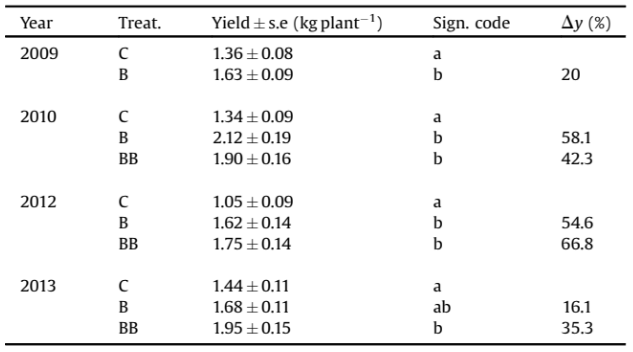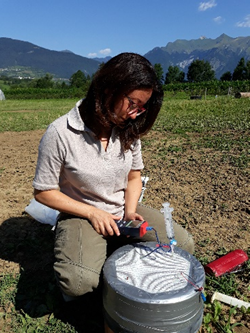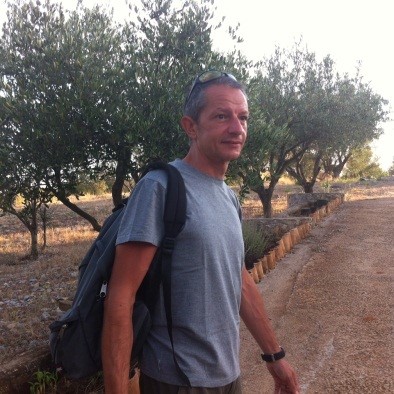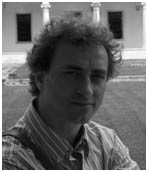By Silvia Baronti, Francesco Primo Vaccari, Lorenzo Genesio, Anita Maienza
Vineyards management is aimed to the maximization of grape yields and quality, includes crop residues removal, strict weed and pest control treatments. These conventional practices have a strong environmental impact over long time periods and also on the fundamental soil physio-chemical and biological parameters (texture, pH, soil organic matter, biodiversity). In the climate change chalange, the choice of appropriate soil strategies can prevent loss of soil fertility and contribute to create a sustainable vineyard management on long term.
The use of biochar is a potential practice that allows restoration of degraded soils together with a significant contribute to mitigation of effect of climate change in agriculture. Biochar is a carbon rich material obtained by the pyrolysis/gasification of biomass and is a promising negative emission technology. Recently, the adoption of a biochar-based strategy management was encouraged by the special report of Intergovernmental Panel on Climate Change in 2018 to contribute to climate change adaptation and mitigation.
Vineyard managers’ interest in biochar has increased because of its potential to improve soil water-holding capacity to aid grape production during drought. Moreover vineyard biomass from vine removal and pruned wood can be converted to biochar in a circular economy perspective.
The Biochar Lab group of the Institute of Biometeorology of Florence (CNR IBIMET) starts in 2007 some field experiments to verify if the biochar could be a viable option also for the agriculture.
Ten years ago, the Biochar Lab of IBIMET started the first field trial on a vineyard of Marchesi Antinori – La Braccesca Estate, close to Montepulciano, Tuscany, Central. The Merlot vineyard was planted in 1995 and on 2009 was amended with 22t/ha of Biochar and with other 22t/ha on 2010. The trial is still in progress and also after 10 years the biochar effect on soil it can see directly (Figure 1).

The results collected during these years are exciting: we published an increase in grape production (up to 66%) of the plots treated with biochar without a decrease of the grape quality (Genesio et al. 2015) (Table 1), an increase in plant-soil water relations (Baronti et al 2014) (Figure 2) no concentrations of soil PAHs (Rombolà et al., 2019; Rombolà et al., 2015) and no eco-toxicity effect (Maienza et al., 2017) over long term.
In the latest paper, published on the journal Geoderma, were showed the long term effect on soil quality, demonstrating how the biochar incorporation to soil, not only has potential contribute to carbon sequestration, but also has a positive effect on soil chemical and biological parameters, even many years from a single application (Giagnoni et al., 2019).



These results encouraging other vineyard managers’ to adopt the biochar strategy with the start of other field long experiments this year in Tuscany:
- Poggio Torselli Estate, San Casciano Val di Pesa (Firenze)
- Experimental Estate of the Tuscany Region Cesa (Arezzo) at planting phase (Figure 4).

The Italian research on the effect of biochar in viticulture is now in the position to provide an effective contribution in mitigating climate change and we hope that this will be an example for other Mediterranean countries.
Biochar could be more extensively used in the future if it were produced more efficiently and in greater volume to make it more affordable, and/or if regulators mandate requirements for carbon sequestration and greenhouse gas (GHG) emissions for agriculture, or increase requirements related to air pollution and nitrogen management.

Silvia Baronti
Research interest focus on plant physiology and ecophysiology, investigating the physiological and biochemical parameters in the correlation between plant resistance and tolerance to biotic and abiotic factors. Relevant experience in environmental physiology, carbon cycle research and Climate Change Mitigation in the agricultural sector. Experience in ecophysiological studies and the measurement of N2O and CO2 fluxes from soils, on the effects of the increasing CO2 in natural and cultivated plants, on modelling and monitoring fluxes and biomass /Net Primary Productivity measurement in agroecosystems using the eddy covariance techniques.

Francesco Primo Vaccari
PhD in Ecology and Environmental Systems, (2010).
Permanent Research Scientist at Institute of Biometeorology – National Research Council (IBIMET CNR) (since (2002- present). Research Interests : Plant Ecology; Climate Change Impact & Mitigation; Effects of high CO2 on crops and natural ecosystems; Biosphere atmosphere interactions; Biochar.

Lorenzo Genesio
Senior Researcher at Institute for Biometeorology of CNR, Florence his Scientific interests and highlights concerns Biosphere-atmosphere interactions and carbon balance; Agronomic research on biochar and feedbacks on the earth system; Early warning systems for food security;Remote-sensing and micrometeorological applications for precision agriculture and precision viticulture; Ecophysiological studies on temperate and sub-tropical agro-ecosystems. Desertification sensitivity assessment.

Anita Maienza
Biologist, PhD in Forestry Ecology. I’m leading experience on the propose of soil practices that, preserve biodiversity, increase soil carbon content and mitigate the effect of climate change, first of all the study of biochar in soils.
References
- Baronti S, Vaccari FP, Miglietta F, Calzolari C, Lugato E, Orlandini S, Pini R, Zulian C, Genesio L (2014) Impact of biochar application on plant water relations in Vitis vinifera (L.) Eur J Agron 53:38–44.
- Genesio L, Miglietta F, Baronti S, Vaccari FP (2015) Biochar increases vineyard productivity without affecting grape quality: results from a four years field experiment in Tuscany. Agric Ecosys Environ 201: 20–25. https://doi.org/10.1016/j.agee.2014.11.021
- Giagnoni, L., Maienza, A., Baronti, S., Vaccari, F. P., Genesio, L., Taiti, C., … & Mancuso, S. (2019). Long-term soil biological fertility, volatile organic compounds and chemical properties in a vineyard soil after biochar amendment. Geoderma, 344, 127-136.
- Maienza, A., Baronti, S., Cincinelli, A., Martellini, T., Grisolia, A., Miglietta, F., … & Genesio, L. (2017). Biochar improves the fertility of a Mediterranean vineyard without toxic impact on the microbial community. Agronomy for Sustainable Development, 37(5), 47.
- Rombolà, A. G., Meredith, W., Snape, C. E., Baronti, S., Genesio, L., Vaccari, F. P., … & Fabbri, D. (2015). Fate of soil organic carbon and polycyclic aromatic hydrocarbons in a vineyard soil treated with biochar. Environmental science & technology, 49(18), 11037-11044.

